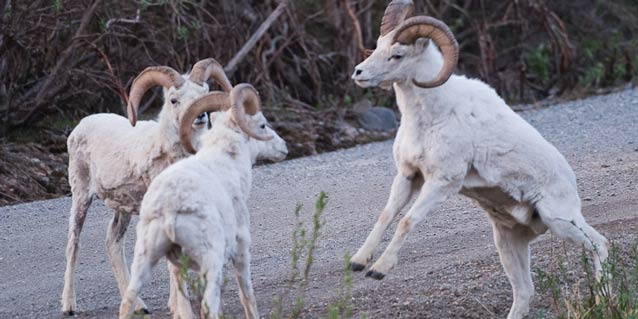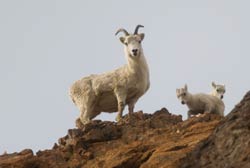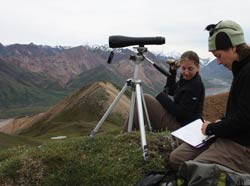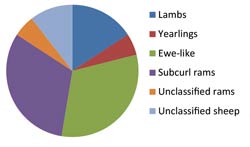Whether visitors on a bus into Denali National Park and Preserve spot “white dots with legs” high on the craggy slopes of Igloo or Cathedral Mountain, or experience full-curl rams smacking horns on the rocks of Polychrome, there is no better iconic image for wildlife protection in the park than the Dall’s sheep.
On July 12, 1939, a band of fifty-two ewes, lambs, and yearlings were feeding on some rather gentle slopes of Cathedral Mountain. Adolph Murie, in "A Naturalist in Alaska"

NPS Photo
Most visitors quickly learn that the protection of Dall’s sheep (Ovis dalli) was the primary driving force in the creation of Mount McKinley National Park in 1917. When Charles Sheldon roamed the foothills of the Alaska Range approximately 100 years ago, he became concerned about the population of Alaska’s “white sheep,” wondering if it would be overexploited for food by explorers and gold seekers. Sheldon successfully lobbied Congress for a game refuge.
If Sheldon visited Denali today, he might be pleased to learn that Dall’s sheep are still prevalent in the park’s mountainous areas between 3,000 and 6,000 feet (1,000 to 2,000 meters) in elevation. However, he might be surprised to learn that the sheep population within the original park boundary remains of high importance to wildlife managers because it is one of the few sheep populations in North America that is not currently hunted and still shares its range with a natural complement of large predators. He also might not have predicted that Dall’s sheep populations are monitored now in a systematic way, using aerial flights and rigorous statistical methods.

NPS Photo
Dall's Sheep Natural History
Dall’s sheep use ridges and steep slopes for feeding and resting, and the rocks and crags to elude predators. During summer, food is abundant, and sheep consume a wide variety of plants. Their winter diet is much more limited and consists primarily of frozen grass and sedge stems.
As a high-altitude species with very specific habitat needs, populations of Dall’s sheep may be sensitive to, and an indicator of, climate and vegetation change. Dall’s sheep populations may fluctuate in response to a number of environmental factors. Sudden population declines may occur as a result of severe winter weather. Low birth rates, combined with predation by wolves, coyotes, and eagles, tend to keep population growth rates low.
Rams, Ewes, and Lambs
Male Dall’s sheep (rams) have massive curling horns and live in bands that seldom associate with female (ewe) groups except during the mating season, or rut, in late November and early December. A sheep’s age can be determined by counting the growth rings (annuli) in the horns. As rams mature, their horns form a circle when seen from the side and reach a full circle or “curl” in seven to eight years.
Ewes have shorter, more slender, slightly curved horns. Normally, ewes have their first lamb at age three and produce one lamb annually. In late May or early June as “lambing” approaches, ewes seek solitude and protection from predators in the most rugged, rocky terrain available on their spring ranges. Data about the age and sex ratios of sheep groups are important for understanding changes in population size over time.

NSP Photo
Survey Efforts Over the Years
Aerial techniques to collect data about sheep abundance within the park have varied over time. Abundance estimates of sheep within the traditional survey units east of the Muldrow Glacier have ranged from 1,104 to 2,280 individuals since 1934. The inconsistencies in methods and in effort in ground-based or aerial surveys have made it difficult for managers to determine true trends in abundance.
To improve data quality, Central Alaska Network biologists developed a new aerial survey method, and it was used for the first time in Denali in 2011. Observers fly over established transects (yellow squiggly lines on map) at different elevations and count sheep. Later biologists employ statistical analyses to estimate total population size and confidence intervals. This survey method can be completed in a few days (e.g., three days in 2011), yet cover a broad area (see map).

NPS Image
Survey Results in 2011 and 2012
The aerial 2011 survey in the east area (shaded dark gray on map) yielded an estimate of 1,867 sheep (with a high confidence that the count falls between 1,476 and 2,443). For comparison, the 2008 count for the survey area equivalent to the east area count was 1,526, and the 1996 count was 1,563. The sheep population in the west area (shaded light gray) was estimated at 505 in 2011. Thus the total estimate of sheep for the north side of the Alaska Range in 2011 was 2,321 (between 1,840 and 3,030).
Most of the sheep observed during the 2011 aerial surveys were “ewe-like” (female sheep or young male sheep with small slender horns). Ground-based counts provide better information about age and sex composition of sheep groups than aerial surveys, because observers are able to use spotting scopes to more accurately classify a sheep (see pie chart above).
In 2012, the ground-based estimate of productivity (ratio of lambs to ewe-like sheep) was 10.9, the lowest recorded productivity since 1993 (see bar graph above). Over the last five years, productivity has been as high as 40.3 (2008). The average number of sheep observed in ram groups was 4.6, with at least one ram solitary, and a high of 12 in a group. For ewe groups (ewes, juvenile rams, and lambs), the average number of sheep per group was 10.3 (the number ranged from 3 to 18).

NPS Image
Management Implications
The results of the 2011 survey suggest that sheep numbers have been stable since the mid-1990s. It is unclear how low lamb productivity in 2012 will impact the population. Biologists will continue aerial Dall’s sheep surveys every three years and ground-based surveys yearly. As another measure to insure the stability of sheep populations, park managers have instituted “sheep gap spacing,” i.e., 10-minute pauses in traffic every hour at certain mileposts, to allow sheep to cross the park road. Although Charles Sheldon never envisioned that protecting sheep would involve regulating traffic, he would likely be pleased that Dall’s sheep are still a priority in “his” park.
Part of a series of articles titled Denali Fact Sheets: Biology.
Last updated: April 22, 2016
